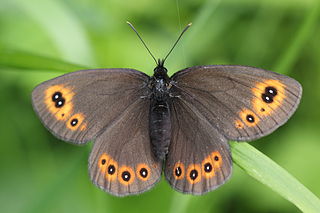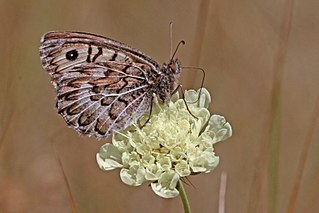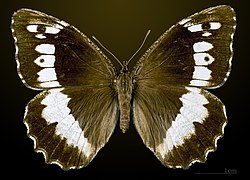
The meadow brown is a butterfly found in the Palearctic realm. Its range includes Europe south of 62°N, Russia eastwards to the Urals, Asia Minor, Iraq, Iran, North Africa and the Canary Islands. The larvae feed on grasses.

The silver-washed fritillary is a common and variable butterfly found over much of the Palearctic realm – Algeria, Europe and across the Palearctic to Japan.

Melanargia galathea, the marbled white, is a medium-sized butterfly in the family Nymphalidae. Despite its common name and appearance, this butterfly is one of the "browns", of the subfamily Satyrinae.

Aporia crataegi, the black-veined white, is a large butterfly of the family Pieridae. A. crataegi is widespread and common. Its range extends from northwest Africa in the west to Transcaucasia and across the Palearctic to Siberia and Japan in the east. In the south, it is found in Turkey, Cyprus, Israel, Lebanon and Syria. It is not usually present in the British Isles or northern Scandinavia.

Melitaea diamina, the false heath fritillary, is a butterfly of the family Nymphalidae.

Erebia medusa, the woodland ringlet, is a member of the subfamily Satyrinae of the family Nymphalidae.

Coenonympha hero, the scarce heath, is a butterfly species belonging to the family Nymphalidae.

Coenonympha glycerion, the chestnut heath, is a butterfly species belonging to the family Nymphalidae. It can be found in Eastern Europe and east across the Palearctic to Siberia and the Caucasus to North Korea.

Argynnis pandora, the cardinal, is a butterfly of the family Nymphalidae. It is common throughout southern Europe and is also found in northern Africa and the Middle east and then east across the Palearctic to the Tian-Shan andnorthwestern India.

Boloria dia, the Weaver's fritillary or violet fritillary, is a butterfly in the family Nymphalidae. The name Weaver's fritillary is in honor of Richard Weaver, an English insect collector who claimed to have obtained the specimen within ten miles of Birmingham around 1820. However, B. dia is very rare in England and the few specimens known from there are thought to be from possibly accidental introductions.

Melitaea didyma, the spotted fritillary or red-band fritillary, is a Palearctic butterfly of the family Nymphalidae.

Melitaea phoebe, the knapweed fritillary, is a butterfly of the family Nymphalidae. It is found in the Palearctic realm, except the northernmost locations. It used to include Melitaea telona, recently revalidated as a distinct cryptic species.

Lycaena helle, the violet copper, is a butterfly of the family Lycaenidae. It is found from the Pyrenees to northern Norway and from Belgium east across the Palearctic to Central Asia, Siberia and Amur.The wingspan is 24–26 mm. The butterfly flies from May to July depending on the location.

Chazara briseis, the hermit, is a butterfly species belonging to the family Nymphalidae. It can be found in North Africa, southern Europe, Asia Minor, the Caucasus, Kazakhstan, Central Asia through Afghanistan, and north-western China and Tuva. It is found on steppe and in other dry grassy places between 500 and 2,500 meters.

Boloria pales, the shepherd's fritillary, is a butterfly of the family Nymphalidae. It is found from the Cantabrian Mountains and the Pyrenees through the Alps and Apennine Mountains east to the Balkan, Carpathian Mountains, the Caucasus and central Asia up to western China.

Muschampia proto, the sage skipper, is a butterfly of the family Hesperiidae. It is found in Morocco, Algeria, the Iberian Peninsula and southern France.

Erebia melampus, the lesser mountain ringlet, is a member of the subfamily Satyrinae of the family Nymphalidae.

Chazara persephone, the dark rockbrown, is a butterfly species belonging to the family Nymphalidae. It can be found from Crimea across the Caucasus and north of the Middle East to Iran; from the southern Urals across Kazakhstan to the southern Altai and west Siberia.

Pseudochazara geyeri, the Grey Asian grayling is a species of butterfly in the family Nymphalidae. It is confined to Albania, Greece, North Macedonia, eastern Turkey and south-western Transcaucasia.

Pseudochazara hippolyte is a species of butterfly in the family Nymphalidae. It is confined from the southern Urals across Kazakhstan and northern Tian-Shan to Transbaikalia, Mongolia and northern Tibet.





























